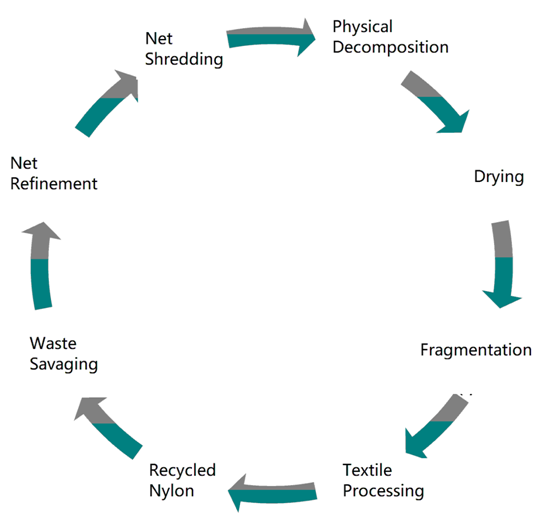Smart Energy-Efficient Waste Recycling: A Case Study of Treating Abandoned Fishing Nets
Written by Elyse Chen and J. M. Wang
Recyclable materials such as plastic bottles and fishing nets are commonly found offshore and can potentially be savaged and treated as materials for a wide range of products. The demand for shoe replacement accounts for 20%, and the replacement rate for ready-made clothing is 40-50%, making recycling such waste in a smart city context commercially viable. However, central to the successful recycling of such waste requires suppliers to provide data on carbon emissions and carbon footprints, making the process both economical and sustainable. This article, therefore, looks at optimizing energy consumption in the process of recycling using a case study of collecting abandoned fishing nets.
Introduction
Many smart cities deal with the increasing environmental challenges posed by climate change and resource depletion, making the need for sustainable practices in various industries more pressing. One such industry that has significant implications for both marine ecosystems and global food security is fishing. Fishing nets, being deployed and subsequently abandoned in vast quantities, possess substantial safety threats to vessels and the environment. The improper disposal and abandonment of these nets have led to severe environmental consequences, including the entanglement of marine animals and the persistence of ghost nets that continue to trap and kill marine organisms long after they have been discarded. In response to this critical issue, the concept of smart energy-efficient fishing net recycling has emerged as an innovative and environmentally conscious solution [1].
Smart energy-efficient fishing net recycling involves the implementation of advanced technologies and sustainable practices to address the environmental impact of discarded fishing nets. It focuses on the efficient collection, processing, and repurposing of these nets to minimize waste and conserve resources that can be applied to power optimization using AI methodologies [2]. This approach leverages cutting-edge technologies such as the Internet of Things (IoT), artificial intelligence (AI), and renewable energy sources to create an interconnected and sustainable system for managing fishing net waste [3].
Methodology
The key objectives of smart energy-efficient fishing net recycling encompass several crucial aspects. Firstly, it aims to develop efficient methods for collecting discarded fishing nets from the sea, coastal areas, and fishing communities. This process involves utilizing GPS tracking systems and autonomous devices to locate and retrieve abandoned nets, reducing the likelihood of entanglement and harm to marine life during the collection phase. Figure 1 shows the flow of wastewater treatment. According to the type of sewage, it can be divided into organic and inorganic. Organic sewage mainly comes from food, dyeing and finishing, and daily life. Treatment technologies for organic sewage usually include chemical wall breaking and microbial treatment. The inorganic sewage comes from electric railways, printed circuits, and optoelectronics. The treatment technology for this type of sewage mainly involves physical adsorption and chemical imitation.
Figure 1: Treatment Process.
Smart energy-efficient fishing net recycling emphasizes the importance of effective net processing and repurposing techniques. Traditional methods often involve energy-intensive processes that contribute to carbon emissions and environmental degradation. However, by incorporating renewable energy sources such as solar or wind power into the net processing facilities, the recycling process can significantly reduce its carbon footprint [4].
Furthermore, smart energy-efficient fishing net recycling promotes the development of innovative materials and products derived from recycled fishing nets. These materials can be utilized in various industries, including fashion, construction, and manufacturing, reducing the demand for raw resources and decreasing the overall environmental impact associated with these sectors. The process of treating fishing nets is shown in Figure 2, where recycling of abandoned fishing nets go through the selection and classification of pelagic and offshore fishing nets using an associative classification scheme proposed by [5]. Followed by refining through high-temperature drying and crushing processing before physical cleaning. This yields molten polymerization granulation that can be converted into recycled materials.
Figure 2: Fishing Net Recycling
The approach emphasizes the importance of raising awareness and educating fishing communities, industry stakeholders, and the general public about the environmental consequences of improper fishing net disposal. By fostering a sense of responsibility and encouraging sustainable fishing practices, smart energy-efficient fishing net recycling aims to create a long-lasting positive impact on marine ecosystems and the global fishing industry.
Conclusion
Smart energy-efficient fishing net recycling presents a compelling solution to address the ecological challenges caused by discarded fishing nets. By leveraging advanced technologies and sustainable practices, this approach aims to collect, process, and repurpose fishing nets in an efficient and environmentally conscious manner. Through its multifaceted objectives, smart energy-efficient fishing net recycling endeavors to safeguard marine ecosystems, promote resource conservation, and foster a more sustainable future for both smart city sustainability and the manufacturing industry.
References
- Kim, H., Mokdad, L., & Ben-Othman, J. (2018). Designing UAV surveillance frameworks for smart city and extensive ocean with differential perspectives. IEEE Communications Magazine, 56(4), 98-104.
- Fong, B., Fong, A., Hong, G., & Tsang, K. F. (2022). Optimization of power usage in a smart nursing home environment. IEEE Transactions on Industry Applications, 59(1), 38-46.
- Wu, Chung Kit, et al. "Critical Internet of Things: An interworking solution to improve service reliability." IEEE Communications Magazine 58, no. 1 (2020): 74-79.
- Lai, C. S., et al. (2017). A comprehensive review on large-scale photovoltaic system with applications of electrical energy storage. Renewable and Sustainable Energy Reviews, 78, 439-451.
- Do, Tien Dung, et al. "Associative classification with artificial immune system." IEEE Transactions on Evolutionary Computation 13, no. 2 (2008): 217-228.
Keywords: Energy efficiency; Green manufacturing; Smart waste;
This article was edited by Bernard Fong.
To view all articles in this issue, please go to June 2023 eNewsletter. For a downloadable copy, please visit the IEEE Smart Cities Resource Center.


To have the eNewsletter delivered monthly to your inbox, join the IEEE Smart Cities Community.
Past Issues
To view archived articles, and issues, which deliver rich insight into the forces shaping the future of the smart cities. Older eNewsletter can be found here. To download full issues, visit the publications section of the IEEE Smart Cities Resource Center.





